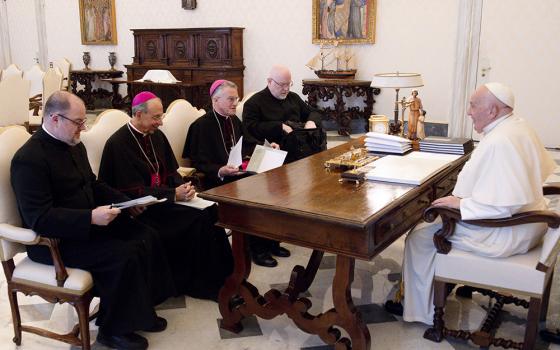
After NCR published letters to the editor received from all over the globe to an opinion piece published Dec. 18 titled "Is sipping from the Communion cup a hazard to your health?," even more letters flooded our inbox. The article was written by Jesuit Fr. Thomas S. Acker, Ph.D., the administrator at St. Joseph Parish in Randolph, Ohio, and Brian Cain, M.D., a parishioner there and a family practitioner for 27 years. The following letters have been edited for length and clarity.
After reading the article by Jesuit Fr. Thomas S. Acker and Brian Cain, I am struck by their myopic approach to "sipping from the communion cup." Clearly, they are not two of the 3 million Americans that have Celiac disease, an autoimmune disease which prohibits the ingestion of gluten.
Unless those with celiac are among the fortunate few communicants who attend a parish that will provide "gluten free" hosts (which, by the way, because of Vatican prescription are not allowed to be entirely wheat free, but still contain minute traces of wheat), participation in communion is by and large dependent upon the availability of the cup.

As it is, availability of the cup is inconsistent at best. Many Masses don't offer it at all. For just moment, imagine always having to weigh physical well-being against spiritual well-being. Alas, I am chagrined by their ignorance, which is clearly informing their bias.
J. OFFNER
Middletown, Connecticut
***
As long as physical contact is made any article — priest's fingers, recipient's saliva and tongue — the wine, the host, the cup, and the cleansing towel has the potential of harboring an infectious agent. This potential is real and may be expressed in illness depending on the integrity and consequent response of the individual's immune mechanism. It has no dependence on a spiritual or theological realm.
The church recognized this phenomenon several years ago when it altered the traditional blessing of throats with two candles applied to the neck on the Feast of St. Blaise. St. Blaise is "the patron saint of sore throats." To avoid exposure to the bacterial agent causing this illness, the customary blessing with crossed candles applied to the necks of individuals has stopped. The same precautions should apply to the Communion cup.
RAYMOND A. ROGOWSKI
Glen Mills, Pennsylvania
***
I fully affirm with one of the letter writers that through the consecration of the elements the bread becomes the living body of the risen Jesus and the wine becomes his blood.
But I have to disagree, as a sacramental theologian, that in the change the bread is annihilated and likewise the wine. What happens is that Jesus Christ is present and given to us in both the form of bread and the form of wine. Those forms his presence take are signs to us of his intention and purpose in giving himself to us in these two ways — as nourishment, repair and refreshment of his relationship with us and with one another.
(Fr.) BRIAN GLEESON, CP
Endeavour Hills, Victoria, Australia
***
I was fascinated by the correspondence following your article on this subject.
I would just add that Anglicans have been receiving from a common cup for over five centuries without, I believed, sparking an outbreak of bubonic plague. Some places allow intinction — which seems to me to be widespread in the Episcopal Church in the U.S.
Here in Wales it is only permitted for the Communion minister — not the communicant — to intinct. This is often ignored and fingers get dipped along with the host. I suppose the Lord should have known better than to issue such an irresponsible invitation to all and sundry.
(The Rev.) LISTER TONGE
Newport, Wales
***
Protect the health of Catholics by transferring the Communion cup back to where it started, the homes of Catholics. Over time the hierarchy has moved the sacred table too far from our homes anyway.
JOHN CHUCHMAN
Scottsdale, Arizona
***
If we believe only in science, the bread and wine will remain bread and wine even after the consecration. If we really believe in the transubstantiation of the bread and wine into body and blood of Jesus. That belief is strong enough to resist any infection.
So the matter is to be decided by each faithful.
K. C. THOMAS
Navi Mumbai, India
***
I have read thoroughly both NCR articles on communion from the common cup.
The conclusions presented both for and against the practice seem to ignore the widespread teachings from our bishops during the flu season, January through Easter. Most American dioceses advise local pastors to suspend communion under both species and the usual handshake of peace during this time. Often the trigger is public health announcements of special precautions people should take once the spread of the flu becomes "epidemic."
Probably as an abundance of caution, this advice from our bishops is to be accepted in the spirit in which it is given.
However, it certainly lends credence to the health concerns raised in the first article.
As a deacon at Mass, it has become my responsibility to do the cleansing of the Communion vessels which includes consuming any remaining consecrated wine, crumbs and dust from hosts, and finally rinsing and consuming water used to cleanse all the distribution vessels. The claim about gold plating rendering some germs inactive is very curious. So is the alcohol content in the consecrated wine considered to be effective in killing germs.
Intinction has many problems, too. So does Communion on the tongue. Wiping the edge of the chalice between communicants is not perfect and the cloth often gets well stained.
Both articles are short on science and long on belief. We can and should do better than this. Public health and Communion practices are at stake.
(Deacon) MIKE EVANS
Anderson, California
***
Sipping from the communal Communion cup is, I believe, far, far, less of a hazard than simply going to Mass. The coughing, the closeness of the congregation, shaking hands during the Sign of Peace, holding hands (if you do it) during the Lord's Prayer, even taking the consecrated host or receiving it on the tongue all require a closeness that is more conducive to viral and bacterial passage from one to another than a tiny sip from the cup.
At our church, eucharistic ministers use a hand sanitizer before distributing the Eucharist. But I see this as very much a side issue to the very, very real issues facing the church today.
MIKE DOELLMAN
Pocatello, Idaho
Advertisement
***
I was amused to read the article by a medical doctor regarding the hazards posed to the faithful receiving the blood in a common cup.
As a High-Church Episcopalian, I recall a similar controversy that played out in the pages of The Living Church (a conservative Episcopal journal) more than 40 years ago.
As I recall, the arguments ranged from the physical (the precious metal in the cup automatically sterilizes it, and the purificator wipes away stray germs) to the mystical (the Holy Spirit will not permit you to get sick from drinking the most precious blood of the savior).
What struck me about the NCR article, however, was the degree to which the author, without any substantive research, just assumed that the common cup was a cesspool of disease.
Anglicans have been receiving out of a common cup since the recent unpleasantness in the 16th century separated us from Rome. Indeed, one of the 39 Articles of Religion (number 30) legislates that "the cup of the Lord is not to be denied to the lay-people."
So we have a little bit more experience with the actual dangers of the cup than your writer does. Anglicans in general, and Episcopalians in particular, are not prone to come down with hideous diseases if they frequently communicate — even in flu season.
What concerned me most about the article, however, was the alarmist nature of the article which may have the effect of causing the faithful to absent themselves from the table of the Lord.
TOM BECKWITH
Denver, Colorado
***
The issue in drinking from a shared Communion cup is cultural, not medical. We live in a North American culture which has long abhorred drinking or eating from shared utensils, be they cups, glasses, plates, spoons, whatever. When I was a boy in Missouri, there were tin cups hanging by a string from all the public water faucets and everybody used them. Today that is not done; it is not even legal.
If parents today found out that kids in the grade school were regularly drinking from the same cups or glasses, there would be a holy uproar and it would stop in a twinkling. Bottom line: it is intensely against the grain of our culture to drink from a shared cup and has been for a long time. (And, I might add, not without reason.)
We Catholics cannot change that. We should not even want to change that! I do not think that it is our role as Catholics to correct the public health conceptions of our culture, or any culture (unless they are dangerously harmful). Historically, we follow the way, formed by Jesus, who himself respected a high-profile public health perception of a specific (first century Jewish) culture: no pork for him.
The church is always an incarnate community: it lives in this place and in this time. I don't think we should be setting up a situation in which being seen as a good or real Catholic requires one to violate one of the major taboos of our own culture. The results are predictable: I have watched many parents over the years discourage their children from sharing the wine, because they are so uncomfortable with the particular way in which we Catholics insist it must be done. In fact, because of that discomfort, many folks in our parish no longer share in the wine. It need not be that way.
Instead, let us follow the lead of other Christian churches who have found multiple respectful and effective ways of sharing the wine without violating the taboo against drinking out of the same cup. Let us follow their example. A healthily incarnate and ecumenical Christian community can do no less.
JOSEPH FOY
Hantsport, Nova Scotia, Canada
Join the Conversation
Send your thoughts and ideas, reactions and responses to letters@ncronline.org. The editor will collect them, curate them and publish a sampling in Letters to the Editor online or in our print edition.
We cannot publish everything. We will do our best to represent the full range of letters received. Here are the rules:
- Letters to the editor should be submitted to letters@ncronline.org.
- Letters to the editor should be limited to 250 words.
- Letters must include your name, street address, city, state and zip code. We will publish your name and city, state, but not your full address.
- If the letter refers to a specific article published at ncronline.org, please send in the headline or the link of the article.
- Please include a daytime telephone number where we can reach you. We will not publish your phone number. It may be used for verification.
- We can't guarantee publication of all letters, but you can be assured that your submission will receive careful consideration.
- Published letters may be edited for length and style.




